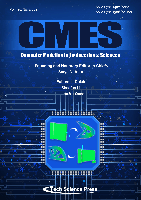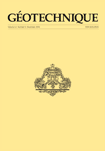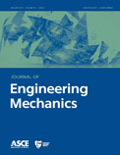
COMPUTERS AND GEOTECHNICS
Scope & Guideline
Innovating Geotechnical Research through Computational Methodologies.
Introduction
Aims and Scopes
- Computational Modelling in Geotechnics:
The journal emphasizes the development and application of computational models, including finite element methods (FEM), discrete element methods (DEM), and boundary element methods (BEM), to simulate the behavior of soils and rock under various loading conditions. - Hydro-Mechanical Coupling:
A significant focus is placed on the interactions between hydraulic and mechanical processes in geotechnical systems, particularly in unsaturated soils and during excavation, tunneling, and foundation processes. - Innovative Material Behavior Modelling:
Research often includes the development of advanced constitutive models that capture the complex behavior of geomaterials, including effects of particle shape, anisotropy, and non-linear behavior under various loading conditions. - Risk and Reliability Analysis:
The journal also covers probabilistic approaches for assessing the reliability and stability of geotechnical structures, focusing on the impact of spatial variability of soil properties and uncertainties in geotechnical design. - Application of Machine Learning and AI:
Emerging methodologies that incorporate machine learning, artificial intelligence, and data-driven approaches to enhance predictive capabilities and optimize geotechnical design are increasingly represented. - Environmental Geotechnics:
The journal publishes research addressing the interactions between geotechnical engineering and environmental factors, including studies on contamination, remediation, and the behavior of materials under climatic influences.
Trending and Emerging
- Advanced Numerical Simulation Techniques:
There is a significant increase in research utilizing advanced numerical simulation techniques, such as hybrid FEM-DEM models, to address complex geotechnical problems, including those involving nonlinear material behavior and large deformations. - Multi-Field Coupling Models:
Emerging studies focus on multi-field coupling models that integrate hydrological, thermal, and mechanical processes, particularly in unsaturated soils and environmental geotechnics, showcasing the importance of holistic approaches to geotechnical challenges. - Machine Learning and Data-Driven Approaches:
The integration of machine learning and data-driven methodologies in geotechnical engineering is on the rise, with research focusing on predictive modeling, optimization of design parameters, and real-time monitoring applications. - Environmental Impact Assessments:
There is a growing trend towards research that addresses the environmental implications of geotechnical structures, including studies on contamination, climate change effects, and sustainable practices in geotechnical engineering. - Behavior of Complex Soil-Structure Interactions:
Increasing attention is being paid to the behavior of soil-structure interactions, particularly in the context of dynamic loading scenarios and advanced foundation systems, highlighting the need for more sophisticated modeling techniques. - Nonlinear and Time-Dependent Behavior Analysis:
Research exploring the nonlinear and time-dependent behavior of geomaterials under various loading conditions is gaining prominence, reflecting the need to understand the long-term performance of geotechnical structures.
Declining or Waning
- Traditional Analytical Methods:
There has been a noticeable decline in the publication of papers solely focused on traditional analytical methods for geotechnical analysis, as the field increasingly shifts towards computational and numerical approaches. - Basic Soil Mechanics Studies:
Research papers that focus exclusively on fundamental soil mechanics principles without integration of advanced computational techniques or novel applications have become less common, reflecting a shift towards more applied and complex problem-solving. - Static Analysis Approaches:
Static analyses, particularly those that do not incorporate dynamic or time-dependent effects, are receiving less attention, as the field moves towards understanding the behavior of soils under dynamic loading conditions, such as seismic events. - Simplistic Models without Empirical Validation:
There is a waning interest in simplistic theoretical models that lack robust empirical validation, as the community increasingly favors models that incorporate complex interactions and are supported by extensive field or laboratory data. - Standard Laboratory Testing Methods:
Papers focusing solely on standard laboratory testing methods for soil characterization are becoming less frequent, as the emphasis shifts towards integrating testing with computational modeling and field data.
Similar Journals

International Journal of Engineering Research in Africa
Shaping Sustainable Engineering PracticesThe International Journal of Engineering Research in Africa is a pivotal academic resource for researchers, professionals, and students interested in the multifaceted field of engineering within the African context. Published by TRANS TECH PUBLICATIONS LTD, this journal facilitates the dissemination of innovative research, covering a myriad of topics in engineering, from advanced materials to sustainable practices. With an ISSN of 1663-3571 and E-ISSN 1663-4144, this publication not only fosters scholarly communication but also contributes to the global engineering discourse, as evidenced by its current Q3 ranking in the Engineering (miscellaneous) category in 2023. Operating from its base in Switzerland, the journal has been actively publishing since 2010 and continues to play a vital role in the advancement of engineering knowledge, particularly in the African landscape. Although it does not offer an open access model, the journal's commitment to quality research ensures that it remains a valuable asset for those seeking to understand and innovate within the engineering sector. Its integration in Scopus with a rank of #175 out of 307 in General Engineering further underscores its relevance and impact in the engineering community.

CMES-COMPUTER MODELING IN ENGINEERING & SCIENCES
Bridging Theory and Practice in Engineering SciencesCMES-COMPUTER MODELING IN ENGINEERING & SCIENCES is a premier journal published by Tech Science Press, dedicated to advancing knowledge in the fields of computer science applications, modeling and simulation, and software engineering. With an impressive convergence of research from 2000 to 2024, this journal stands out as a vital resource for researchers, professionals, and students alike, fostering innovation and collaboration in computational methodologies. The journal currently holds a Q3 category ranking in multiple disciplines according to the latest metrics, including Scopus, which reflects its growing significance in the academic community. By providing a platform for high-quality research and open discourse, CMES aims to enhance the understanding of complex systems through effective modeling techniques and computational tools. Despite its current classification under open access, the journal remains a cornerstone for those looking to deepen their expertise in cutting-edge computational engineering and science.

COMPUTATIONAL MECHANICS
Unveiling New Horizons in Computational MechanicsCOMPUTATIONAL MECHANICS, published by SPRINGER, is a premier international journal that focuses on the intersection of applied mathematics, engineering, and computational methods. With a commendable Q1 ranking in multiple categories, including Applied Mathematics and Mechanical Engineering, this journal is pivotal for disseminating groundbreaking research and innovative methodologies that advance the field. The journal has steadily contributed to the academic community since its inception in 1986 and continues to lead discussions and practices in computational mechanics and related disciplines. With a robust impact reflected in its Scopus rankings—placing it within the top percentiles across various categories—COMPUTATIONAL MECHANICS serves as a crucial platform for researchers, professionals, and students seeking to explore and contribute to significant advancements in computational theory and mathematical applications. Although it does not currently operate under an open access model, the journal ensures wide accessibility through libraries and institutional subscriptions, fostering a rich exchange of knowledge in the global scientific community.

GEOTECHNIQUE
Exploring Earth Sciences to Build Tomorrow's FoundationsGEOTECHNIQUE is a prestigious peer-reviewed journal published by Emerald Group Publishing Ltd, specializing in the fields of Geotechnical Engineering and Earth and Planetary Sciences. Established in 1948, this journal has consistently delivered groundbreaking research and advancements in the science of soil and rock mechanics, engineering geology, and environmental applications, aiming to foster innovation in geotechnical practices. With an impressive impact factor reflected in its Q1 ranking within both the Earth and Planetary Sciences and Geotechnical Engineering categories, GEOTECHNIQUE is recognized as a leading source of scholarly articles, positioning itself among the top 5% in the field. The journal is accessible via subscription, providing a repository of invaluable insights for researchers, professionals, and students striving to push the boundaries of knowledge and application in geotechnical topics. With a robust editorial board and a commitment to excellence, GEOTECHNIQUE continues to contribute significantly to the academic community and the practical engineering landscape.

International Journal of Physical Modelling in Geotechnics
Pioneering insights for sustainable infrastructure solutions.The International Journal of Physical Modelling in Geotechnics, published by Emerald Group Publishing Ltd, is a leading platform dedicated to advancing the field of geotechnical engineering and engineering geology. With a focus on the practical applications of physical modeling, this journal contributes significantly to the understanding of soil and rock behavior under various conditions, making it invaluable for researchers, professionals, and students alike. Heightened by its Q2 ranking in its category and a notable 61st percentile ranking among its peers, this journal has established itself as a credible source of knowledge and innovation within the academic community. Although it does not currently offer open access, its rigorous peer-review standards ensure the dissemination of high-quality research and insights. The journal, covering a timeline of topics from 2011 to 2024, aims to bridge the gap between theory and practice, ultimately fostering advancements in geotechnical solutions necessary for infrastructure development. To stay at the forefront of geotechnical research, contributing authors and engaged readers are encouraged to explore and participate in this dynamic academic discussion.

Modelling
Catalyzing Research in Engineering, Science, and Math.Modelling is a distinguished open access journal published by MDPI since 2020, dedicated to advancing the field of computational modeling across various scientific disciplines including Computer Science, Engineering, and Mathematics. With its base in Switzerland, the journal aims to foster a collaborative environment for researchers and practitioners while providing a platform for high-quality research on modeling and simulation techniques. As of 2023, it has garnered respectable rankings, achieving Q3 in Computer Science and Mathematics, and Q2 in Engineering, with notable Scopus values indicating an increasing impact within the academic community. Modelling not only publishes innovative research findings but also encourages the dissemination and discussion of emerging methodologies, making it a vital resource for scholars seeking to contribute to and expand the frontiers of knowledge in their respective fields. As an open access journal, it promotes unrestricted access to research outputs, ensuring greater visibility and impact for researchers and students alike.

JOURNAL OF ENGINEERING MECHANICS
Pioneering Research in Engineering MechanicsJOURNAL OF ENGINEERING MECHANICS, published by the ASCE - American Society of Civil Engineers, stands as a premier interdisciplinary journal in the field of engineering mechanics. With an impact factor reflecting its vital contributions—placing it in the Q1 category for both Mechanical Engineering and Mechanics of Materials—this journal has established itself as a critical resource for researchers and professionals alike. Since its inception in 1981 and continuing through 2024, it has provided a platform for the dissemination of high-quality research, emphasizing innovative methodologies and cutting-edge findings. The journal's ranking in Scopus further underscores its significance, with impressive standings in the 79th and 77th percentiles of its respective categories. As a vital resource for students and professionals aiming to stay abreast of developments in engineering mechanics, it remains committed to fostering rigorous scientific exploration and practical applications within the field.

Computers and Concrete
Advancing the Future of Concrete EngineeringComputers and Concrete is a leading academic journal published by TECHNO-PRESS, focusing on the interdisciplinary field of computational mechanics as applied to civil engineering and concrete materials. With an impressive impact factor consistent with its status in its category, this journal holds a prestigious Q1 ranking in Computational Mechanics for 2023, being recognized as one of the top journals within this domain. Since its inception in 2006, Computers and Concrete has provided a vital platform for researchers and professionals to disseminate innovative findings, fostering collaboration and knowledge exchange among an engaged community. The journal is available in both print and digital formats, ensuring accessibility to a wide audience of academics and practitioners alike. By featuring high-quality research articles, review papers, and technical notes, this journal plays a crucial role in advancing the understanding and application of computational techniques in the field of concrete and structural engineering.

FINITE ELEMENTS IN ANALYSIS AND DESIGN
Exploring the frontiers of computational mechanics.FINITE ELEMENTS IN ANALYSIS AND DESIGN, published by Elsevier, is a leading international journal dedicated to advancing the field of engineering analysis using finite element techniques. With a strong focus on theoretical and applied contributions, the journal spans a broad spectrum of subjects, including structural analysis, computational mechanics, and computer graphics applications, making it an essential resource for researchers, professionals, and students alike. As evidenced by its impressive Q1 ranking in multiple categories, including Analysis and Computer Graphics, and its Scopus rankings placing it in the top 10% across several fields, it serves as a vital platform for disseminating cutting-edge research and innovative applications within the field. The journal, with an ISSN of 0168-874X and an E-ISSN of 1872-6925, publishes articles that emphasize rigorous mathematical methodologies and computational advancements, ensuring high relevance for contemporary engineering challenges. With a history extending from 1985 to 2024, it continues to shape the discourse and progress within the finite element community.

Studia Geotechnica et Mechanica
Empowering Engineers with Cutting-edge Insights and DiscoveriesStudia Geotechnica et Mechanica is a distinguished academic journal dedicated to the vital fields of geotechnics, civil engineering, and materials science. Published by SCIENDO, this Open Access journal has been facilitating unrestricted access to research since 2012, allowing for wide dissemination of innovative findings and methodologies. Based in Poland, it contributes significantly to the scholarly community by providing a platform for the exchange of ideas, techniques, and advancements relevant to Civil and Structural Engineering, Geotechnical Engineering, and related disciplines. With an increasing emphasis on applied research, Studia Geotechnica et Mechanica is classified in various quartiles, demonstrating its emerging influence in fields such as Computers in Earth Sciences and Mechanics of Materials. The journal is indexed in Scopus, showcasing its commitment to maintaining high academic standards. By publishing peer-reviewed research articles, this journal is essential for researchers, professionals, and students looking to stay at the forefront of developments in these critical areas of engineering and science.